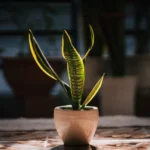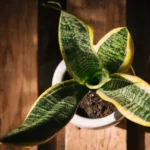When you grow a plant, many of us want to know how long it will take. The snake plant is so popular, it only makes sense that people are curious as to how long they can expect to wait for it to grow to full size.
From a cutting, the snake plant will usually take 3-4 weeks to start growing roots. From there, it will take about 6-8 weeks for the roots to fully grow. And the plant will start growing about 4-6 weeks after being potted.
To reach full size, the plant will usually take 2 weeks to a year.
Table of Contents
How big do Snake Plants get?
It’s kind of a tricky question, “How big do snake plants grow?” because there are so many of them. Some are so small, you can easily fit them onto your desk, others are so big, you’ll need to keep them in the corner of the room.
The biggest snake plant is the Laurentili. It can grow up to 3ft high and have leaves 2 inches wide. Perhaps not ideal if you live in a small flat.
The smallest snake plant is the Fischeri. This one only grows up to about 16 inches tall, so the perfect plant to keep on your desk.
Your typical snake plant will probably be about 1 metre high.
Snake Plant Growth Rate
From cutting to tiny roots
When you’re using propagation to grow a snake plant, the first step will be to allow a cutting to grow roots. You can do this by placing it in a small tub of water and waiting for some small roots to start sprouting.
Generally speaking, this will take about 3-4 weeks. Although it may take longer if it’s a bigger variety, or shorter if the conditions are excellent.
Once it has its roots, you can move it from the water to a pot.
From small roots to full roots
From here, you will need to allow your roots to grow even further. If you want a large plant, you’re going to have a lot of roots. While the roots are growing, they will be absorbing nutrients from the soil. But because it’s still a baby, it will likely be a slow eater.
At this point, it may take about 6-8 weeks for the roots to grow to full size. But again, it might be less or more time depending on the conditions you’re keeping it in and the variety of snake plant you’re growing.
But you need to allow this time so that your roots can be at the optimum level of health.
From pot to plant
It might sound like when snake plants grow, the roots grow fully, then the rest of the plant follows. But this is not the case.
The plant and the roots will be growing at the same time. As the roots get bigger, the plant grows with them. This leads to the question of “How long after the roots emerging does growth start”?
Usually, the plant will start growing 4-6 weeks after the cutting has been potted. From there, it can take anything from a few months to a few years for it to reach its full length- it all depends on how big it’s going to be.
How to speed up your Snake Plant’s growth rate
Sunlight
One of the best ways to speed up the growth of your snake plant is to make sure it’s getting enough sunlight. As most of you will already know, plants get their energy from the sun. This happens through a process called Photosynthesis. And when plants have a lot of energy, they will use that energy for getting bigger.
Make sure to keep your snake plant in a room with plenty of filtered sunlight. This will mean keeping the curtains open.
Big pot
Another way to speed up the growth of your snake plant is to make sure the pot it’s in is big enough. As we spoke about earlier, a big plant needs big roots to support it.
And you can’t expect the roots to grow to the size you need them to if the pot they’re in is too small.
Having a larger pot may also be beneficial to the plant as it will reduce the chances of getting root rot. When your plant’s roots are rotten, they can’t absorb any of the minerals in the soil, and therefore will seriously stunt the growth.
Temperature
Plants are incredibly fickle things. If you want your plant to be perfect, you’re going to have to make sure the environment is ideal. And one aspect of the environment that can make or break any plant is the temperature.
With any plant, the ideal temperature is whatever temperature it would usually find in its natural habitat. With the snake plant, this is anywhere from 55-85F.
Also, try and avoid sudden temperature changes. This will mean keeping it away from drafts, air con units, and heating units.
Fertilizer
Plants need energy from the sun, but they also need nutrients from the soil. Without nutrients, the plant would not be able to repair its cells. And with no cell repair, you can forget about growth.
For this reason, it’s super important you make sure to feed your plant with fertilizer. The snake plant doesn’t need a lot of fertilizer. Just a couple of times a month during the spring and summer, and you should be fine.
Too much fertilizer and it can develop root rot, which is going to hugely stunt its growth. But giving it a few nutrients will go down a treat.
Water
The snake plant, just like any other plant, needs to be watered sometimes. Just like animal cells, the majority of a plant cell is made up of water. This water will be used up and evaporate, so it will need to be replaced.
You should water your snake plant every 2-8 weeks, depending on its size and environment. If the top 2 inches of the soil are dry, it needs a drink.
But be careful not to overwater as this is the leading cause of root rot in snake plants. You don’t want to drown the roots.
How to slow your Snake Plant’s growth rate
Cut the tips
The most effective way to stunt the growth of your snake plants without killing them is to clip the leaves. And there is a very interesting reason for this.
In this tip of a snake plant’s leaves, there is a hormone that encourages upward growth. When you cut the leaves’ tips, you cut off the part of the part that contains this hormone.
Without the hormone telling it to grow up, your snake plant will wait until the leaf tips are recovered before they continue growing.
This should always be done with clean instruments.
Smaller pot
The second way to stunt the growth of a snake plant is to move it to a smaller pot. Remember how earlier we said that a bigger pot will cause quicker growth?
Using that logic, it shouldn’t be hard to figure out that a small pot is best for slower growth. When your plant is in a smaller pot, the roots will be forced to become self-contained and stop growing. Because the leaves can’t grow too far from the base, they will stop growing quicker than they would in a bigger pot.
A small plant only needs small roots to keep itself alive.
How to alter growth direction
Maybe it’s not the rate of growth you have a problem with. But rather, the direction. The whole point of house plants is that they look nice. When your leaves are going off in every direction under the sun, it ruins the look!
The solution to this is quite simply to cut off the leaves going in the wrong direction. With the snake plant, cutting off leaves is okay because they have a rhizome root system.
Rhizome roots are roots that grow horizontally. This allows new shoots to grow when old ones die- or are cut off.
Indoors vs Outdoors
To get the best growth rate out of your snake plant, you may be wondering if it’s better to keep it indoors or outdoors, and it all depends.
Outdoors has more access to the sun, and there is less chance of overwatering if you live in a hot area.
However, indoors, there is more carbon dioxide, and in cold places, it tends to be warmer.
Whether your snake plant would do better indoors or outdoors depends on where it lives. In climates similar to its natural habitat, outdoors is better, but for most of us, we’ll be better off keeping our snake plants inside.
Conclusion
The growth rate of the snake plant is more complicated than we might think. Factors that can significantly influence it are the environment and the variety of snake plant you have.
But hopefully, after reading this article, you have a better idea of what you can expect and at what time. And if you want your snake plant to grow faster or slower, you also have some idea of how to go about going that.
Whether you want your snake plant to be desk-sized or make it go as big as possible, that’s entirely up to you.
Photo by doTERRA International, LLC from Pexels


